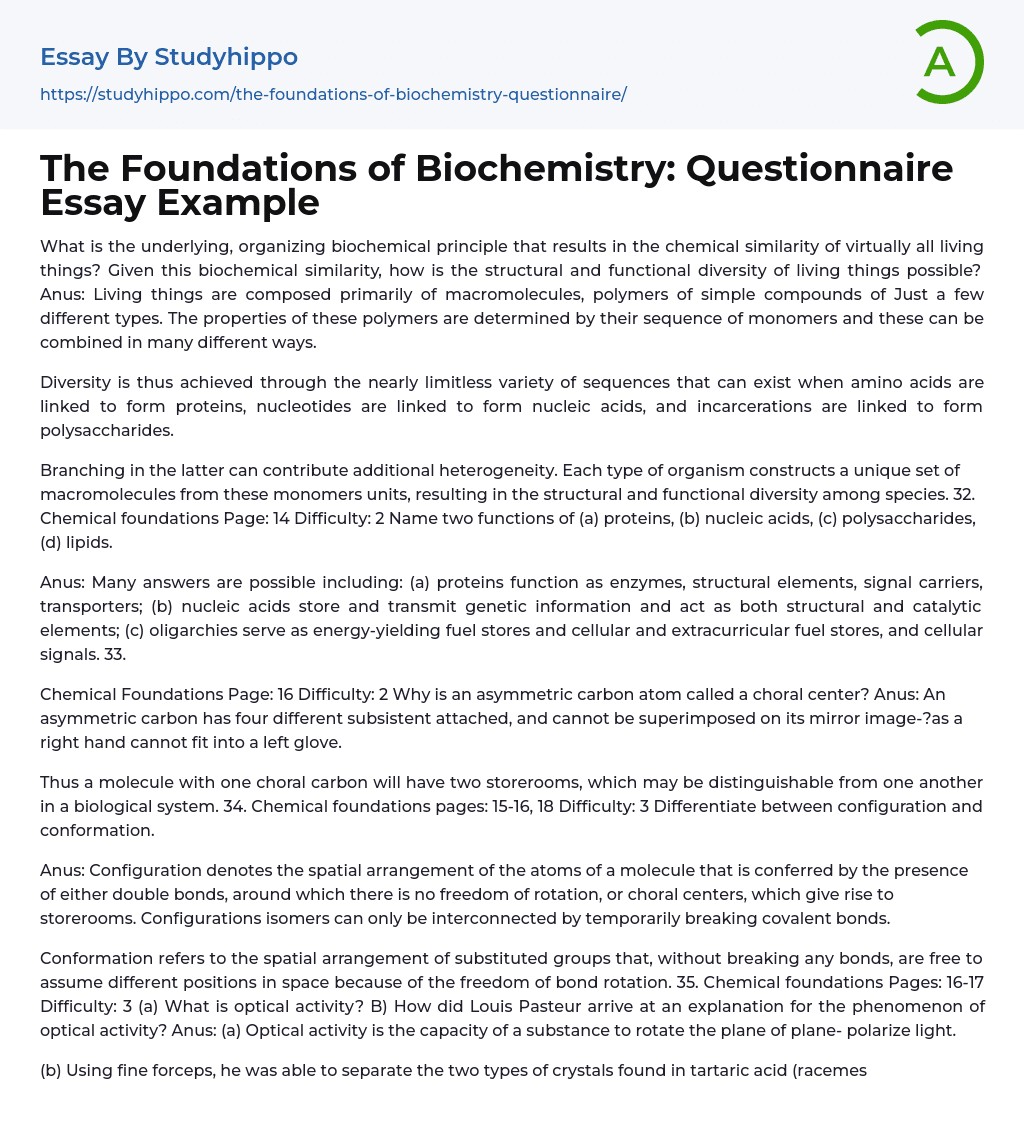

The Foundations of Biochemistry: Questionnaire Essay Example
The topic of interest is the fundamental biochemical principle that explains why living things are chemically alike. Despite this similarity, there exists a wide range of diversity in the structure and function of living organisms. Macromolecules are predominantly what make up living beings, which are polymers formed from several types of simple compounds. The order in which these monomers are arranged determines the properties exhibited by these polymers, with countless sequence combinations possible between amino acids, nucleotides, and carbohydrates further increasing natural diversity. Each organism can create its unique collection of macromolecules using these building blocks to allow for varying functional and structural variety across species. Proteins serve as enzymes, signal carriers, structural elements and transporters while nucleic acids store and transmit genetic information as well as act as catalytic elements or supporting
... structures. Polysaccharides store energy for cells and their signals while lipids play various roles within biological systems too.
Chemical Foundations Page 16 with a difficulty level of 2 offers an explanation on why we call an asymmetric carbon atom a chiral center: it has four different substances attached to it making it impossible to superimpose onto its mirror image - just like how your right hand cannot fit into a left glove!In a biological system, a molecule with one chiral carbon will have two distinguishable stereoisomers. Chemical Foundations Pages 15-16 and 18 explain the difference between configuration and conformation, which refer to the spatial arrangement of atoms or substituted groups within a molecule. Configuration isomers can only be connected by breaking covalent bonds, while conformational differences arise from the freedom of bond rotation. Optical activity refers to a substance's ability to rotate plane-polarized
light, and Louis Pasteur discovered that mirror-image crystals of tartaric acid (racemic acid) rotate polarized light in opposite directions. One sample rotates it to the left while the other rotates it to the right.Information regarding the synthesis and testing of stereoisomers can be found in Chemical foundations on pages 18-19, with a difficulty level of 3. In pharmaceutical labs, it is important to separate each moiety of a drug's racemic mixture and test its biological activity because different stereoisomers may have vastly different effects on an organism - one moiety could be beneficial while the other may be toxic or ineffective in decreasing the efficacy of the other. Anus explains that living organisms produce specific chiral forms of biomolecules while laboratory chemical synthesis generally produces racemic mixtures using chiral reagents. Enzymes are inherently chiral catalysts due to being made from chiral precursors, resulting in strong stereoselectivity in reactants and mechanisms producing chiral products. This information is also explained in Chemical foundations. Additionally, Physical foundations (with a difficulty level of 2) reveals that proteins are consistently synthesized by living cells without overproduction leading to cell destruction through natural turnover and degradation processes, maintaining dynamic steady state under appropriate conditions. This process applies similarly to Anus.
- Organic Chemistry essays
- Acid essays
- Calcium essays
- Chemical Bond essays
- Chemical Reaction essays
- Chromatography essays
- Ethanol essays
- Hydrogen essays
- Periodic Table essays
- Titration essays
- Chemical reactions essays
- Osmosis essays
- Carbohydrate essays
- Carbon essays
- Ph essays
- Diffusion essays
- Copper essays
- Salt essays
- Concentration essays
- Sodium essays
- Distillation essays
- Amylase essays
- Magnesium essays
- Acid Rain essays
- Mutation essays
- Oxygen essays
- Atmosphere essays
- Coral Reef essays
- Desert essays
- Earth essays
- Ocean essays
- Lake essays
- Sea essays
- Biodiversity essays
- Natural Environment essays
- Forest essays
- Soil essays
- Water essays
- Rainbow essays
- Ecosystem essays
- Volcano essays
- Wind essays
- Forestry essays
- Bottled Water essays
- Agriculture essays
- Albert einstein essays
- Animals essays
- Archaeology essays
- Bear essays
- Biology essays



